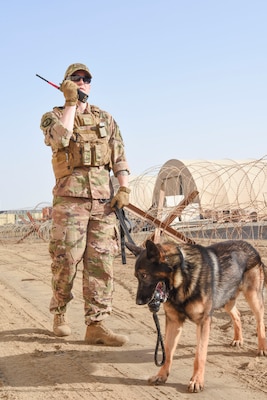
AL DHAFRA AIR BASE, United Arab Emirates (AFNS), Jan. 18, 2019 — The 380th Expeditionary Security Forces Squadron military working dogs team conducted a small-scale training event with 380th Expeditionary Civil Engineer Squadron’s Explosive Ordnance Disposal and fire department Jan. 15 at Al Dhafra Air Base.
This training allowed different squadrons to work simultaneously on various areas while improving their joint operations.
“The most important purpose is to improve the working relationship with these organizations,” said Tech. Sgt. Mark Allen, 380th Expeditionary Security Force Squadron military working dog handler. “It isn’t often that you can get multiple agencies together for a normal training exercise, this usually happen when Inspector General-, Wing- or Air Force-level inspections are occurring. This training not only helps the partnership between us, but also allows the opportunity to get significant training without worrying about a pass or fail.”
The MWD team was tested on observing and locating a training aid, their K-9’s explosive detection capability and the handler’s ability to communicate the situation to EOD and fire department members when they arrive on scene.
“This scenario focused on the handler not getting tunnel vision during a search,” said Allen. “Most of the time, we would have a spotter but I wanted to see how my handler would respond when he was alone. I also wanted to see how my handler would do as on-scene commander until the appropriate agency arrives on scene.”
The fire department trained and certified members on plotting and cordoning off the area, while EOD members trained on operating their robot and operational procedures. Ultimately, this enabled them to evaluate how accurately they follow protocols during responses.
“It is important to try to make these scenarios as realistic as we can in a training environment,” said Tech. Sgt. Charles Hall, supply and munitions NCO in charge. “This includes having other agencies that would normally be involved in a real-life event participate, allowing each team to learn not only their roles and capabilities, but also the roles and capabilities of everyone else. It also allows our teams to work out any discrepancies or misunderstandings between agencies before having to come together for a real incident.”
Joint training scenarios like this ensure better communications between different sections and improves the effectiveness of Al Dhafra AB’s base defense.
“By including other squadrons and flights, it not only helps them prepare, but it also establishes more efficient and effective actions during a response,” added Allen. “At the end of the day, we are part of this amazing team here and the only way to make the team better is to practice together. It’s nice that we can each do our own portion of the mission, but it’s great to see how different units respond and mold together into one team to accomplish the required task.”



